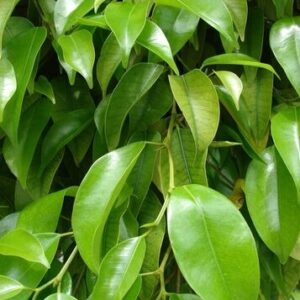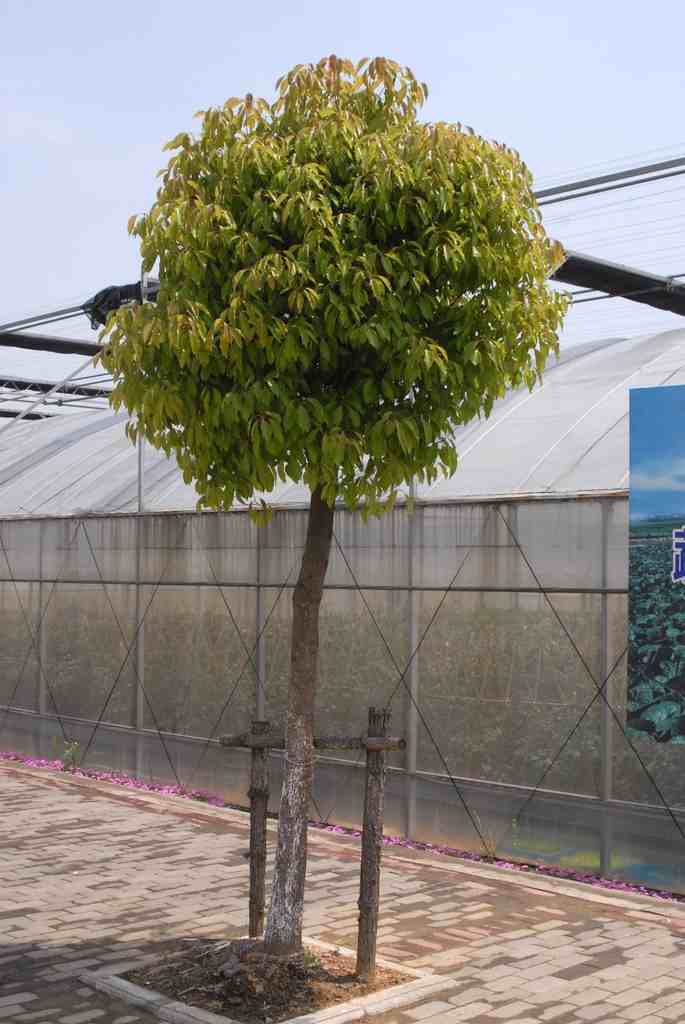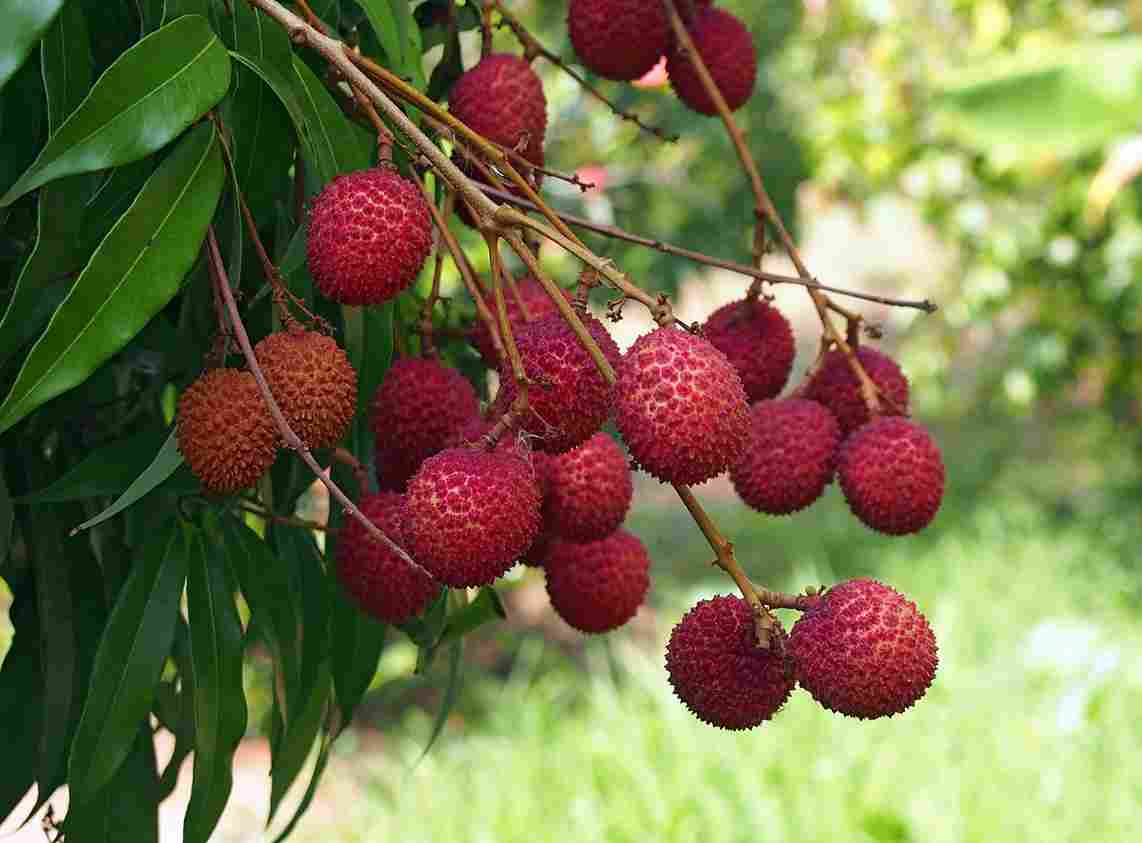Fruits & Trees
-

 Sale!10%
Sale!10%Ficus Tree Green ‘Weeping Fig’
₨ 250.00 – ₨ 1,800.00The Weeping Fig (Ficus benjamina), also known as the Benjamin Fig or Ficus Tree, is a popular indoor plant renowned for its elegant appearance and graceful, arching branches. The Weeping Fig is known for its ability to help purify indoor air by removing toxins such as formaldehyde, xylene, and toluene, making it a beneficial addition to homes and offices.
In various cultures, the Ficus tree is considered a symbol of peace, abundance, and prosperity. It’s often believed that having a Weeping Fig in the home can bring positive energy and a sense of tranquility. In Feng Shui, the Weeping Fig is sometimes used to create a harmonious and balanced environment. Its presence is thought to promote good luck, prosperity, and a peaceful atmosphere, particularly when placed in a well-lit area that encourages healthy growth.
NOTE: Actual product may vary due to product enhancement
-

 Sale!10%
Sale!10%Ficus Tree Variegated ‘Weeping Fig’
₨ 250.00 – ₨ 1,800.00The Ficus benjamina ‘Variegata’, features distinctive variegated leaves with a mix of white and green. This variety maintains the graceful, weeping growth habit of the Weeping Fig and adds a touch of elegance with its contrasting leaf colors. The Weeping Fig is known for its ability to help purify indoor air by removing toxins such as formaldehyde, xylene, and toluene, making it a beneficial addition to homes and offices.
In various cultures, the Ficus tree is considered a symbol of peace, abundance, and prosperity. It’s often believed that having a Weeping Fig in the home can bring positive energy and a sense of tranquility. In Feng Shui, the Weeping Fig is sometimes used to create a harmonious and balanced environment. Its presence is thought to promote good luck, prosperity, and a peaceful atmosphere, particularly when placed in a well-lit area that encourages healthy growth.
NOTE: Actual product may vary due to product enhancement
-

 Sale!10%
Sale!10%Ficus Tree Yellow ‘Weeping Fig’
₨ 250.00 – ₨ 1,800.00The Ficus tree ‘Yellow,’ also known as Ficus benjamina ‘Golden King,’ is a variety of the Weeping Fig that stands out for its vibrant, variegated foliage featuring a mix of yellow and green tones. It retains the characteristic weeping shape and glossy leaves typical of the standard Ficus benjamina, but with a striking color contrast. The Weeping Fig is known for its ability to help purify indoor air by removing toxins such as formaldehyde, xylene, and toluene, making it a beneficial addition to homes and offices.
In various cultures, the Ficus tree is considered a symbol of peace, abundance, and prosperity. It’s often believed that having a Weeping Fig in the home can bring positive energy and a sense of tranquility. In Feng Shui, the Weeping Fig is sometimes used to create a harmonious and balanced environment. Its presence is thought to promote good luck, prosperity, and a peaceful atmosphere, particularly when placed in a well-lit area that encourages healthy growth.
NOTE: Actual product may vary due to product enhancement
-


Grapes
Grapes are widely cherished for their sweet, juicy flavor and versatility. They grow in clusters on vines and come in various colors, including green, red, and black. Grapes are rich in vitamins C and K, antioxidants, and natural sugars, making them a healthy snack and an ingredient in many culinary dishes and beverages, including wine and juice.
Grapevines thrive in well-drained soil and require plenty of sunlight for optimal fruit production. They are suited to temperate climates with a distinct winter chill, which helps with bud development. Regular pruning and proper trellising are essential for maintaining vine health and maximizing yield. Grapevines are relatively low-maintenance but benefit from consistent watering and occasional fertilization.
NOTE: Actual product may vary due to product enhancement
-


Hybrid Mango
Hybrid Mango refers to mango varieties developed by crossbreeding different mango species or cultivars to enhance specific traits, such as flavor, size, and disease resistance. These hybrids often combine the best qualities of their parent varieties, resulting in fruits that are sweeter, juicier, and more resistant to pests and diseases.
Hybrid mango trees require well-drained soil and a sunny location to thrive. They are best suited to tropical and subtropical climates, where they can produce fruit year-round. Regular watering, fertilization, and pruning help maintain tree health and encourage abundant fruit production. Hybrid mangoes are enjoyed fresh, in smoothies, and various culinary dishes.
NOTE: Actual product may vary due to product enhancement
-


Kalki Tree (Callistemon)
Kalki Tree (often referred to as Sapindus or soapberry tree) is known for its distinctive fruit, which contains saponins that can be used as a natural detergent. The tree is characterized by its large, glossy leaves and small, round fruits that are traditionally used for cleaning and medicinal purposes.
The Kalki Tree thrives in well-drained soil and prefers a sunny location. It is suited to tropical and subtropical climates, where it can grow rapidly and produce its unique fruit. Regular watering and minimal pruning are sufficient to maintain its health and shape. The tree is valued for its ecological benefits and traditional uses.
NOTE: Actual product may vary due to product enhancement
-


Kapur Tree (Cinnamomum Camphora)
Kapur Tree (also known as Cinnamomum or camphor tree) is renowned for its aromatic wood and camphor oil, which is extracted from the bark and used in medicinal and aromatic applications. The tree features large, evergreen leaves and small, inconspicuous flowers that are followed by berry-like fruits.
The Kapur Tree requires well-drained soil and a sunny location for optimal growth. It thrives in tropical and subtropical climates, where it can reach significant heights and produce valuable camphor. Regular watering and occasional pruning help maintain the tree’s health and productivity. The Kapur Tree is often used in landscaping and traditional medicine.
NOTE: Actual product may vary due to product enhancement
-


Karbi Tree (Elaeocarpus Serratus)
Karbi Tree (also known as Carica papaya or papaya tree) is valued for its delicious, tropical fruit and medicinal properties. The tree features large, lobed leaves and produces fruit that is sweet, orange, and rich in vitamins A and C, as well as digestive enzymes.
The Karbi Tree thrives in well-drained soil and requires a sunny location to produce fruit. It is best suited to tropical and subtropical climates. Regular watering and fertilization support healthy growth and fruit production. The tree benefits from occasional pruning to maintain its shape and encourage better fruit yield. Papaya is commonly used fresh, in smoothies, and cooking.
NOTE: Actual product may vary due to product enhancement
-


Khurpani (Apricot)
Khurpani (Apricot) is a small, sweet fruit known for its vibrant orange color and delicate flavor. Apricots are rich in vitamins A and C, dietary fiber, and antioxidants. They can be enjoyed fresh, dried, or used in a variety of culinary applications, such as jams, sauces, and desserts.
Apricot trees require well-drained soil and a sunny location to thrive. They are best suited to temperate climates with a cold winter period that aids in fruit development. Regular pruning helps maintain tree health and enhance fruit production. Apricot trees need consistent watering and occasional fertilization to produce high-quality fruit.
NOTE: Actual product may vary due to product enhancement
-


Kiwi
Kiwi (also known as Actinidia deliciosa) is a tropical fruit known for its unique green flesh, tiny black seeds, and tangy-sweet flavor. Rich in vitamins C and K, dietary fiber, and antioxidants, kiwi is a nutritious addition to the diet and is often used in fruit salads, desserts, and smoothies.
Kiwi vines require well-drained soil and a sunny location for optimal growth. They thrive in temperate climates with a cold winter period that supports bud development. Regular watering and fertilization are important for maintaining vine health and promoting fruit production. Kiwi vines benefit from regular pruning to manage growth and improve fruit yield.
NOTE: Actual product may vary due to product enhancement
-


Lemon (Kagati) Grafted
Lemon Grafted trees are cultivated varieties of lemon trees that have been grafted onto rootstocks to improve fruit quality and tree performance. Grafted lemon trees are known for their consistent fruit production, higher yields, and better disease resistance compared to non-grafted varieties. Lemons are valued for their tart flavor and versatility in culinary applications.
Grafted lemon trees require well-drained soil and a sunny location to thrive. They are best suited to subtropical and tropical climates. Regular watering, fertilization, and pruning help maintain tree health and encourage abundant fruit production. Lemons are used fresh in cooking, baking, and beverages, as well as in cleaning and medicinal applications.
NOTE: Actual product may vary due to product enhancement
-


Litchi
Litchi (also known as Litchi chinensis) is a tropical fruit known for its sweet, floral flavor and translucent white flesh. The fruit is rich in vitamins C and B6, as well as antioxidants and dietary fiber. Litchis are commonly enjoyed fresh or used in desserts and beverages.
Litchi trees thrive in well-drained soil and require a sunny location to produce fruit. They are suited to tropical and subtropical climates with warm temperatures. Regular watering, especially during dry periods, and minimal pruning are essential for maintaining tree health and fruit production. Litchis benefit from a dry season for fruit maturity.
NOTE: Actual product may vary due to product enhancement

